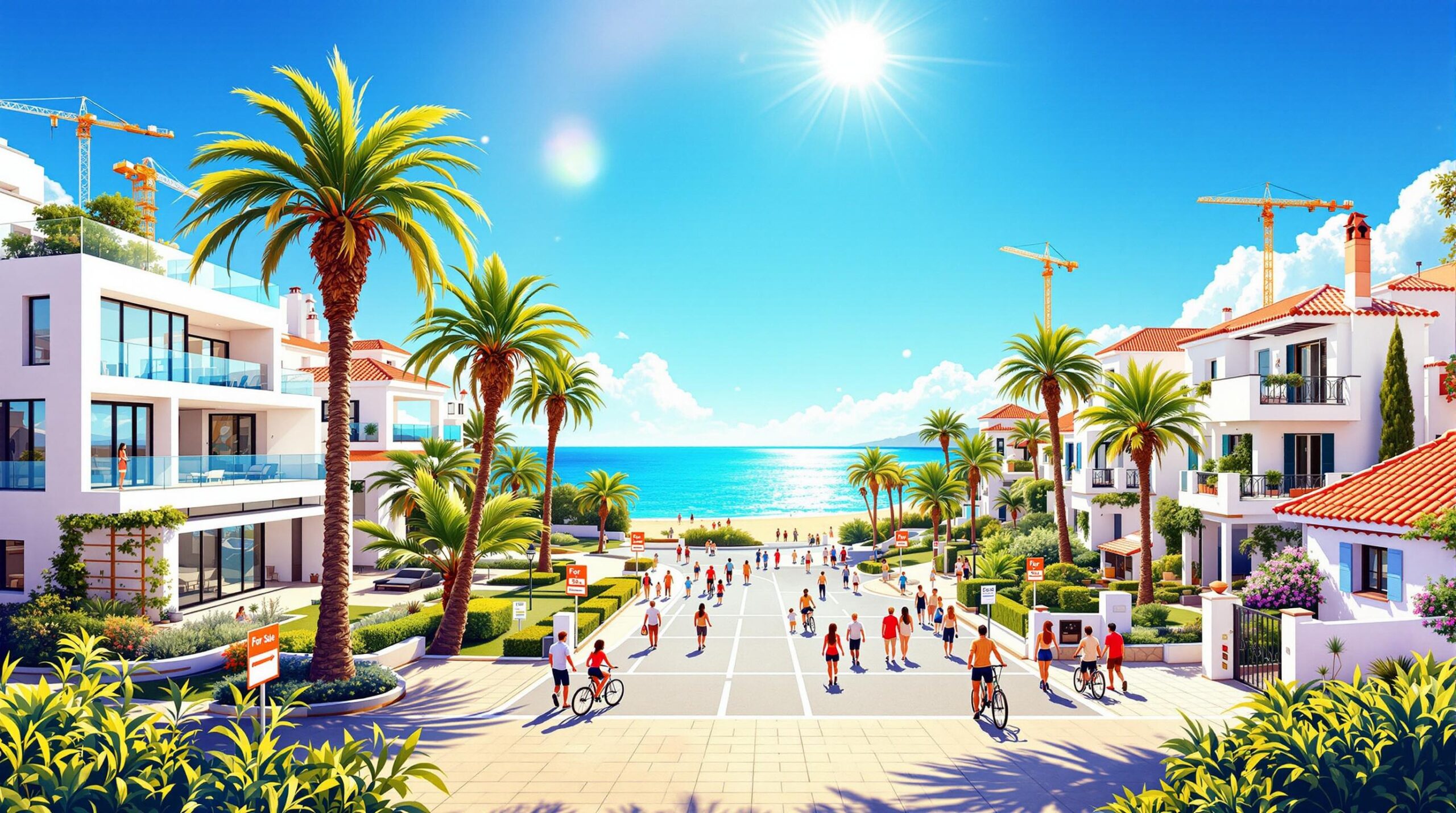¡Hola Future Investor! Unlocking Spain’s Sizzling Property Market
Spain, with its sun-drenched coastlines, vibrant cities, and rich cultural tapestry, has long been a magnet for tourists and lifestyle seekers. But beyond the tapas and flamenco, a dynamic and increasingly sophisticated real estate market is drawing savvy investors from across the globe. The allure is undeniable: a fantastic quality of life, relatively affordable property prices compared to other Western European hotspots, and promising potential for both rental income and capital appreciation. Investing in Spanish real estate is more than just acquiring bricks and mortar; it’s about tapping into a lifestyle and an economic landscape ripe with opportunity. The country has shown remarkable resilience and growth, making its property sector a compelling proposition for those looking to diversify their portfolios. With robust tourism, a growing digital nomad scene, and attractive residency programs like the Golden Visa, Spain is shining brighter than ever on the international investment map. This guide will illuminate the key trends, pinpoint the hotspots, and explore the kinds of projects that are making waves, helping you make informed decisions on your journey to Spanish property success with Kompass Wealth.
The Global Love Affair: Who’s Snapping Up Spanish Property?
Spain’s property market is truly a global melting pot, attracting a diverse array of international buyers eager for a slice of the Mediterranean dream. The motivations are varied, ranging from securing a sun-soaked retirement haven to capitalizing on lucrative rental yields or making strategic portfolio diversifications. This international interest fuels a dynamic market, bringing fresh perspectives and consistent demand across different regions and property types. Understanding who these investors are and what drives them is key to navigating the opportunities available. The sustained influx of foreign capital underscores Spain’s enduring appeal as a stable and attractive investment destination, even amidst global economic shifts. This cosmopolitan demand also enriches local communities and contributes significantly to the Spanish economy, making it a win-win scenario. Let’s delve into the nationalities leading the charge and explore the underlying reasons for their Spanish property passion.
The Usual Suspects: European Neighbours Leading the Charge
For decades, European neighbours have been the bedrock of foreign investment in Spanish real estate, and their enthusiasm shows no signs of waning. British buyers, despite Brexit, continue to represent a significant portion of foreign purchasers, drawn by the established expatriate communities, familiar lifestyle, and favourable climate, especially along the Costas. German investors are also prominent, often seeking high-quality properties in tranquil locations, with a keen eye for sustainability and long-term value, frequently favouring the Balearic Islands and specific areas of the mainland. French buyers, appreciating the cultural similarities and proximity, often invest in Catalonia and along the northern Mediterranean coast, looking for second homes or rental opportunities. Scandinavian investors, including Swedes, Norwegians, and Danes, are increasingly active, attracted by the superb quality of life, modern infrastructure, and the escape from colder northern climates, often investing in new developments with contemporary designs and amenities. Dutch and Belgian buyers are also significant players, typically seeking well-appointed villas and apartments in popular coastal regions, valuing good transport links and community facilities. These European nations share a long history of tourism and an appreciation for the Spanish lifestyle, making property investment a natural extension of their affection for the country. Their consistent demand provides a stable foundation for the market, particularly in established tourist destinations.
Beyond Borders: The Rise of Non-EU Investors
While Europeans form the traditional core, the Spanish property market is increasingly capturing the attention of investors from further afield, significantly broadening its international appeal. American investors are showing a growing interest, partly fueled by a strong dollar, a desire for a European lifestyle, and the perceived value compared to US property markets, often looking at vibrant cities like Madrid and Barcelona or luxury coastal properties. Chinese investors, though their activity has fluctuated with global travel and economic conditions, have been attracted by opportunities like the Golden Visa program, which offers residency in exchange for significant real estate investment, often targeting prime urban locations or new developments. Investors from the Middle East, including the UAE and Saudi Arabia, are also notable, typically focusing on high-end luxury properties in exclusive areas like Marbella, seeking prestige, privacy, and exceptional quality. Latin American investors, particularly from countries like Mexico, Colombia, and Argentina, find Spain attractive due to cultural and linguistic ties, viewing it as a stable gateway to Europe for both investment and personal use. The rise of these non-EU investors brings new capital and diverse preferences into the market, often targeting different segments and contributing to the overall dynamism and resilience of Spanish real estate. This diversification of buyer nationalities is a healthy sign, indicating Spain’s broad and enduring global appeal.
What’s Driving Their Passion for Spanish Bricks and Mortar?
The motivations drawing international investors to Spanish real estate are multifaceted, blending lifestyle aspirations with sound financial reasoning. The exceptional quality of life is undoubtedly a primary driver; Spain offers a wonderful climate with over 300 days of sunshine per year in many regions, a renowned healthy Mediterranean diet, and a relaxed, sociable culture. This lifestyle appeal is compelling for those seeking holiday homes, retirement properties, or even a primary residence in a more enjoyable environment. Secondly, the relative affordability of Spanish property compared to other popular Western European countries like France, Italy, or the UK presents significant value, allowing investors to acquire more for their money. Furthermore, the potential for attractive rental yields is a major draw, particularly in tourist hotspots and major cities with strong year-round demand from both holidaymakers and long-term tenants, including a growing student population and digital nomads. The prospect of capital appreciation also fuels investment, as Spain’s property market has demonstrated long-term growth potential despite cyclical fluctuations. Government initiatives like the Golden Visa program have also played a role, offering non-EU investors a pathway to residency and Schengen Area travel through property purchase. Finally, political stability within the European Union framework provides a sense of security for international investors looking for a safe haven for their capital.
Location, Location, ¡Ubicación!: Hotspots for Savvy Investors
Choosing the right location is paramount in real estate investment, and Spain offers a diverse tapestry of regions each with its unique charm and investment profile. From the bustling, sun-kissed coastlines to the dynamic urban centres and tranquil inland retreats, the ideal spot depends heavily on an investor’s goals, whether it’s high rental yields, long-term capital growth, or a personal lifestyle haven. The country’s varied geography and regional cultures mean that what works in one area might differ significantly in another. Savvy investors understand the importance of researching local market dynamics, infrastructure developments, and tourism trends before committing. Spain’s commitment to improving transport links, such as high-speed rail networks and airport expansions, continually opens up new areas and enhances the attractiveness of existing ones. Identifying these hotspots, both established and emerging, is key to maximizing returns and enjoying the full benefits of a Spanish property investment. Let’s explore some of the most compelling destinations that are currently capturing the attention of discerning buyers.
Sun, Sea, and Solid Returns: The Coastal Allure
The Spanish coasts, or “Costas,” remain perennially popular, and for very good reasons, drawing millions of tourists and property investors annually. The Costa del Sol, stretching along the Andalusian coast, is arguably the most famous, known for its glamorous resorts like Marbella and Puerto Banús, offering luxury villas, upscale apartments, and world-class golf courses, ensuring strong rental demand, particularly in the premium segment. Further east, the Costa Blanca boasts beautiful sandy beaches, charming towns like Jávea and Altea, and a more varied price range, attracting a broad spectrum of European buyers seeking holiday homes and retirement properties. The Balearic Islands, including Mallorca, Ibiza, and Menorca, offer a unique blend of stunning natural beauty, vibrant nightlife (especially Ibiza), and exclusive, high-end properties, commanding premium prices and robust rental income, particularly during the extended summer season. The Canary Islands, with their year-round spring-like climate, are another major draw, with Tenerife and Gran Canaria leading in popularity for both tourism and property investment, offering consistent rental opportunities. These coastal regions benefit from well-developed infrastructure, international airports, and a plethora of amenities catering to an international clientele, making them relatively safe bets for consistent rental income and lifestyle enjoyment. Investment here often focuses on buy-to-let properties, holiday rentals, or luxurious second homes.
Urban Jungles of Opportunity: Madrid & Barcelona’s Enduring Appeal
Spain’s two largest cities, Madrid and Barcelona, are economic powerhouses and cultural epicentres, offering a different but equally compelling investment proposition to the coastal regions. Madrid, the vibrant capital, is a hub for business, finance, and government, attracting a diverse international population of professionals and students, which fuels strong demand for long-term rentals in central districts like Salamanca, Chamberí, and Retiro. The city’s rich cultural scene, excellent transport links, and dynamic atmosphere make it a prime location for those seeking urban sophistication and consistent rental yields, with a growing interest in property refurbishment projects. Barcelona, the cosmopolitan capital of Catalonia, combines stunning architecture, a beachfront city vibe, and a thriving tech scene, making it incredibly popular with both tourists and expatriates. Desirable areas include Eixample, Gràcia, and the Gothic Quarter, where demand for both short-term holiday lets and long-term residential leases is high, though local regulations on tourist rentals need careful navigation. Both cities boast world-class universities, further driving demand for rental accommodation. Investing in these urban jungles typically means focusing on apartments, from chic studios to spacious family homes, with opportunities in both resale properties and new developments offering modern amenities. These cities offer liquidity and potential for steady capital appreciation due to their economic importance and international stature.
Hidden Gems: Emerging Markets and Niche Locations
Beyond the headline-grabbing Costas and major cities, Spain is dotted with emerging markets and niche locations that offer exciting potential for investors willing to look a little further afield. Valencia, Spain’s third-largest city, is increasingly on the radar, offering a fantastic quality of life, beautiful beaches, a historic old town, and the stunning City of Arts and Sciences, all at more affordable property prices than Madrid or Barcelona, attracting both lifestyle buyers and astute investors. Seville, the heart of Andalusia, captivates with its rich history, flamenco culture, and warm climate, showing growing interest in its charming city-centre apartments and traditional townhouses, especially for boutique tourism. The Costa de la Luz, on the Atlantic coast, offers wilder, windswept beaches and a more authentically Spanish experience, appealing to those seeking tranquility and value, with towns like Tarifa becoming kitesurfing meccas. Inland Andalusia, with its picturesque white villages (pueblos blancos), offers rustic properties and fincas at attractive prices, ideal for those seeking a quieter life or a rural tourism venture. Even regions in the north, like Galicia or Asturias, with their lush green landscapes and rugged coastlines, are gaining traction for their natural beauty and lower property prices, appealing to a different demographic of buyer. These hidden gems often provide higher rental yields or greater potential for capital growth as they gain popularity, but typically require more in-depth local knowledge.
Bricks, Mortar, and Big Dreams: Types of Projects Attracting Capital
The Spanish real estate market offers a diverse portfolio of property types, catering to a wide range of investment strategies and lifestyle preferences. From chic city apartments to sprawling coastal villas and innovative new developments, the choices are abundant. Investors are increasingly sophisticated, looking beyond just location to consider the specific characteristics, potential uses, and long-term viability of different property types. The evolving demands of modern living, including sustainability, smart home technology, and flexible spaces, are also shaping investment trends. Whether the goal is a steady rental income, a luxurious holiday retreat, or a commercial venture, understanding the nuances of each project type is crucial for making a successful investment. Spain’s construction sector is also adapting, with a growing emphasis on quality, energy efficiency, and contemporary design, particularly in new builds. Let’s explore the main categories of properties that are currently capturing the imagination and capital of international investors.
Living the Dream: Residential Havens from Apartments to Villas
Residential property remains the cornerstone of real estate investment in Spain, offering a wide spectrum of options to suit different budgets and lifestyle aspirations. Apartments are incredibly popular, especially in urban centres like Madrid, Barcelona, and Valencia, where they cater to young professionals, students, and those seeking a vibrant city life; these range from compact studios ideal for rental to spacious penthouses with stunning city views. Along the coastlines, beachfront apartments and those within holiday complexes with communal pools and gardens are highly sought after for both personal use and lucrative short-term holiday lets. Townhouses, or “adosados,” offer a middle ground, providing more space than an apartment, often with a small private garden or terrace, and are common in suburban areas and coastal resorts, appealing to families and those desiring a community feel. Villas, particularly in prime coastal locations like the Costa del Sol or the Balearic Islands, represent the higher end of the market, offering privacy, luxury amenities such as private pools, and often breathtaking sea views; these are popular as prestigious second homes and high-yield rental properties. Fincas, or country estates, offer a more rustic and traditional Spanish living experience, often found inland, providing ample land and tranquility, attracting those looking to escape the hustle and bustle or even start a small agricultural or equestrian venture. The choice depends heavily on the investor’s goals: rental income, personal enjoyment, or a combination of both.
The Business of Pleasure: Commercial and Tourism-Driven Investments
Beyond residential properties, Spain’s thriving tourism industry and robust economy create significant opportunities in commercial and tourism-driven real estate projects. Hotels and aparthotels are a major focus, particularly in established tourist destinations and bustling cities, with investors looking at everything from boutique hotels in historic buildings to larger resort-style complexes; the consistent influx of tourists makes this a potentially high-return sector, albeit requiring significant capital and management expertise. Retail spaces in high-footfall areas, such as shopping streets in city centres or commercial units within popular tourist resorts, also attract investment, though the rise of e-commerce necessitates careful selection of location and tenant type. Restaurants and bars, especially those with prime locations and established reputations, can be lucrative investments, capitalizing on Spain’s renowned culinary scene and outdoor dining culture. Purpose-built student accommodation is a growing niche in university cities like Salamanca, Granada, Madrid, and Barcelona, addressing the consistent demand from both domestic and international students. Furthermore, investing in commercial premises for co-working spaces is gaining traction, particularly in urban hubs, catering to the increasing number of freelancers, remote workers, and startups. These types of investments typically require a deeper understanding of business operations and market trends but can offer substantial rewards for the discerning investor.
Future Forward: New Developments and Sustainable Builds
New developments and sustainable building projects are increasingly at the forefront of investment trends in Spanish real estate, reflecting a global shift towards modernity, energy efficiency, and environmental consciousness. Off-plan properties, purchased before or during construction, often allow investors to secure properties at a lower price point and potentially customize finishes, offering strong capital appreciation potential upon completion, particularly in high-demand areas. These new builds typically feature contemporary designs, open-plan living spaces, high-quality materials, and modern amenities like smart home technology, communal swimming pools, gyms, and landscaped gardens, appealing to a discerning modern buyer. A significant emphasis is now being placed on sustainability, with developers incorporating energy-efficient designs, solar panels, advanced insulation, and sustainable materials to reduce environmental impact and running costs; these “green” properties are not only ethically appealing but also increasingly demanded by eco-conscious buyers and tenants. Gated communities offering enhanced security and a range of exclusive facilities are also popular, especially in luxury segments along the coast. Investing in these future-forward projects aligns with evolving market preferences and can offer excellent long-term value, better energy ratings, and lower maintenance costs compared to older properties, making them an attractive option for both lifestyle purchasers and buy-to-let investors. The Spanish government and EU initiatives are also promoting greener construction, further boosting this sector.
Show Me the Money! Expected Returns and Future Outlook
Ultimately, any investment decision hinges on the potential returns, and Spanish real estate offers a compelling, albeit varied, landscape in this regard. Returns can manifest as consistent rental income, significant capital appreciation over time, or a blend of both, depending on the property type, location, and market conditions. It’s crucial for investors to conduct thorough due diligence and understand the factors that can influence profitability, including local economic trends, tourism figures, and any regulatory changes. The Spanish property market has demonstrated resilience and a capacity for growth, but like any market, it’s subject to cycles and external influences. Having a clear investment strategy and realistic expectations is key to navigating this dynamic environment successfully. Kompass Wealth can help you analyze these factors to align your investment with your financial goals. Let’s delve into what investors can realistically expect in terms of returns and what the future might hold for this vibrant market.
Crunching the Numbers: Rental Yields and Capital Appreciation
When investing in Spanish property, two primary financial benefits come into play: rental yields and capital appreciation, both of which can be quite attractive. Rental yields, which measure the annual return from rental income relative to the property’s cost, can vary significantly by location and property type. In major cities like Madrid and Barcelona, long-term rental yields typically range from 3% to 5% gross, driven by strong demand from professionals and students. Coastal areas popular with tourists, such as the Costa del Sol or the Balearic Islands, can offer higher gross yields for short-term holiday lets, potentially reaching 6% to 8% or even more during peak season, although this often involves more intensive management and can be subject to seasonality and regulatory restrictions. It’s important to calculate net yields by factoring in operational costs like property taxes (IBI), community fees, insurance, maintenance, and potential letting agency fees. Capital appreciation, the increase in the property’s value over time, is another key component of return; historically, Spanish property has shown solid long-term growth, particularly in prime locations, though it’s subject to market cycles. Areas undergoing regeneration or benefitting from new infrastructure projects often see accelerated capital growth. Investors should consider their time horizon, as capital appreciation is typically a longer-term play, whereas rental income provides more immediate cash flow.
Factors Influencing Your ROI: More Than Just Bricks
The Return on Investment (ROI) from Spanish real estate is influenced by a complex interplay of factors that extend far beyond the physical property itself. Location remains the undisputed king; properties in prime, high-demand areas, whether city centres or sought-after coastal spots, generally offer more stable returns and better appreciation potential. The specific type and condition of the property are also critical; modern, well-maintained properties or those with unique features often command higher rents and resale values. Market conditions at the time of purchase and sale, including interest rates, overall economic health, and specific property market trends, will significantly impact ROI. Effective property management is crucial, especially for rental investments, as good management can maximize occupancy rates, ensure timely rent collection, and keep maintenance costs in check, directly affecting net yields. Tourism trends heavily influence returns in coastal and holiday destinations, so understanding visitor numbers and preferences is key. Furthermore, legal and tax considerations, including purchase taxes, income tax on rental earnings, and capital gains tax, must be factored into any ROI calculation to get a true picture of profitability. Currency exchange rates can also impact returns for international investors not using the Euro. Finally, infrastructure developments, such as new transport links or local amenities, can positively influence property values and rental demand in an area.
Gazing into the Crystal Ball: Spain’s Property Market Forecast
Predicting the future of any property market with certainty is impossible, but current indicators and expert analyses suggest a generally positive and stable outlook for Spanish real estate. The underlying fundamentals remain strong: Spain continues to be a highly desirable destination for tourism, retirement, and lifestyle changes, ensuring sustained demand from both domestic and international buyers. Government investment in infrastructure, coupled with a growing focus on sustainability and technology in new developments, is modernizing the housing stock and enhancing its appeal. While global economic factors, such as inflation and interest rate fluctuations, will undoubtedly play a role, the Spanish market has shown resilience in navigating such challenges previously. Demand for quality housing, particularly in prime locations and energy-efficient new builds, is expected to remain robust. The rise of remote working and the digital nomad culture could also benefit certain regions, increasing demand for flexible living spaces with good connectivity. Areas offering a high quality of life at a relatively affordable price point are likely to continue attracting interest. While rapid, speculative growth might be a thing of the past, steady, sustainable appreciation and healthy rental yields are anticipated in many segments, making Spain a compelling long-term investment proposition for those who choose wisely and conduct thorough research. Partnering with experts like Kompass Wealth can provide valuable insights to navigate future trends.
There you have it! A whirlwind tour of the vibrant Spanish real estate investment scene. From the sun-drenched Costas to the bustling cities, the opportunities are as diverse and exciting as Spain itself.
Ready to turn these insights into action? At Kompass Wealth, we’re here to guide you every step of the way!




